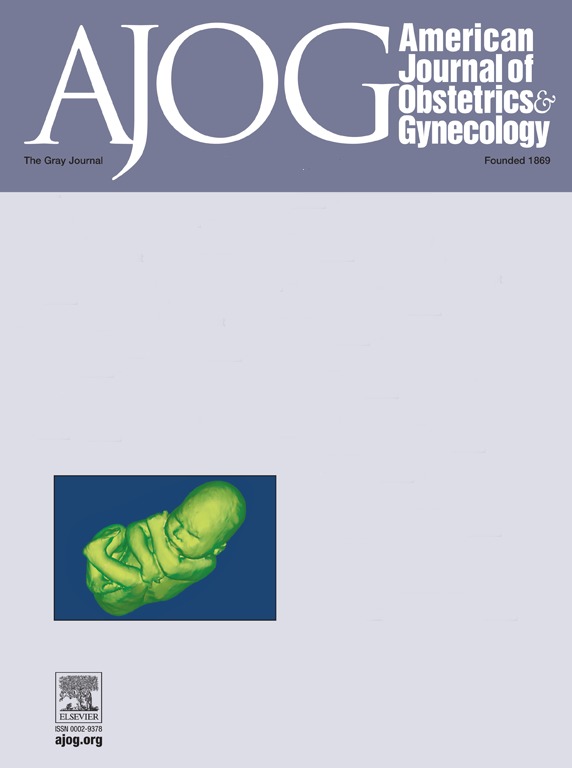Evaluation of a new prediction model for the estimation of risk of obstetric anal sphincter injuries.
IF 8.7
1区 医学
Q1 OBSTETRICS & GYNECOLOGY
引用次数: 0
Abstract
BACKGROUND Obstetric anal sphincter injuries are complications to vaginal birth with potential to cause substantial maternal morbidity. Prediction of these injuries might help to improve maternal care but also antenatal counselling and patient information. Previous attempts to create prediction models have in many cases involved variables only known post-partum which limit their use in an antenatal setting. Other models include parameters that are not applicable to a Northern European population. OBJECTIVE To develop and validate a clinically useful model for prediction of risk of obstetric anal sphincter injuries. STUDY DESIGN The model was developed using a retrospective nationwide cohort from the Swedish Medical Birth Registry consisting of 1,209,421 deliveries between 2005-2016. After exclusion criteria (caesarean section, forceps delivery, missing data) were applied, the data set was randomly divided into a development data (n=422,011) set and a validation data set (n=422,010). Using the development data set all variables were assessed with univariable analysis with modified Poisson regression analysis. A prediction model was then built by multivariate analysis using modified Poisson regression where vaiables with p= <0.2 were included. Both forwards and backwards selection were used and variables with p= >0.05 were excluded. Validation was performed by evaluating the agreement of the predicted and true observed rate of obstetric anal sphincter injuries after the prediction model was applied to the validation data set. RESULTS Primiparity, previous cesarean delivery, previous sphincter injury, increasing age, increasing birth weight and maternal origin from Sub Saharan Africa or South/ Southeast Asia were all antenatal variables associated with increased risk of obstetric anal sphincter injury. Smoking, increasing maternal height and BMI appeared to lower the risk. Vacuum extraction also increased the risk of sphincter injury. We developed one model including previously mentioned antenatal parametres and one also including vacuum extraction. The final prediction model including instrumental delivery can be used for predicting the risk of sphincter injury for delivery with or without vacuum extraction with higher accuracy. This model had good discrimination with AUC 0.79 (95% CI 0.78-0.79) and was able to predict risks up to 24% with good to moderate accuracy. CONCLUSION Using antenatally available data, obstetric anal sphincter injuries can be predicted with moderate certainty. This prediction model has been externally validated and can be used for individualised antenatal counselling as well as identifying persons at high risk where preventative strategies might improve outcomes. Further validation in other populations outside of Scandinavia is recommended before clinical implementation.一种新的产科肛门括约肌损伤风险预测模型的评估。
背景:产科肛门括约肌损伤是阴道分娩的并发症,有可能导致大量的产妇发病率。这些损伤的预测可能有助于改善产妇保健,但也产前咨询和患者信息。以前建立预测模型的尝试在许多情况下只涉及产后已知的变量,这限制了它们在产前环境中的使用。其他模型包括不适用于北欧人口的参数。目的建立并验证一种预测产科肛门括约肌损伤风险的临床实用模型。研究设计:该模型是使用瑞典医疗出生登记处的回顾性全国队列建立的,该队列包括2005-2016年期间的1,209,421例分娩。采用排除标准(剖宫产、产钳分娩、缺失资料)后,将数据集随机分为发展数据集(n=422,011)和验证数据集(n=422,010)。利用发展数据集,采用单变量分析和修正泊松回归分析对所有变量进行评估。采用修正泊松回归进行多变量分析,排除p= 0.05的变量,建立预测模型。将预测模型应用于验证数据集后,通过评估产科肛门括约肌损伤的预测率和真实观察率的一致性来进行验证。结果初产、既往剖宫产、既往括约肌损伤、年龄增加、出生体重增加以及产妇来自撒哈拉以南非洲或南亚/东南亚都是与产科肛门括约肌损伤风险增加相关的产前变量。吸烟、增加母亲的身高和身体质量指数似乎可以降低风险。真空拔牙也增加了括约肌损伤的风险。我们开发了一个模型包括前面提到的产前参数和一个也包括真空提取。包括器械分娩的最终预测模型可用于预测有或无真空抽吸分娩时括约肌损伤的风险,准确性较高。该模型具有良好的鉴别能力,AUC为0.79 (95% CI 0.78-0.79),能够以良好到中等的准确度预测高达24%的风险。结论利用产前资料,产科肛门括约肌损伤具有中等确定性。该预测模型已经过外部验证,可用于个性化产前咨询以及识别高危人群,其中预防策略可能会改善结果。建议在临床应用前在斯堪的纳维亚半岛以外的其他人群进一步验证。
本文章由计算机程序翻译,如有差异,请以英文原文为准。
求助全文
约1分钟内获得全文
求助全文
来源期刊
CiteScore
15.90
自引率
7.10%
发文量
2237
审稿时长
47 days
期刊介绍:
The American Journal of Obstetrics and Gynecology, known as "The Gray Journal," covers the entire spectrum of Obstetrics and Gynecology. It aims to publish original research (clinical and translational), reviews, opinions, video clips, podcasts, and interviews that contribute to understanding health and disease and have the potential to impact the practice of women's healthcare.
Focus Areas:
Diagnosis, Treatment, Prediction, and Prevention: The journal focuses on research related to the diagnosis, treatment, prediction, and prevention of obstetrical and gynecological disorders.
Biology of Reproduction: AJOG publishes work on the biology of reproduction, including studies on reproductive physiology and mechanisms of obstetrical and gynecological diseases.
Content Types:
Original Research: Clinical and translational research articles.
Reviews: Comprehensive reviews providing insights into various aspects of obstetrics and gynecology.
Opinions: Perspectives and opinions on important topics in the field.
Multimedia Content: Video clips, podcasts, and interviews.
Peer Review Process:
All submissions undergo a rigorous peer review process to ensure quality and relevance to the field of obstetrics and gynecology.

 求助内容:
求助内容: 应助结果提醒方式:
应助结果提醒方式:


